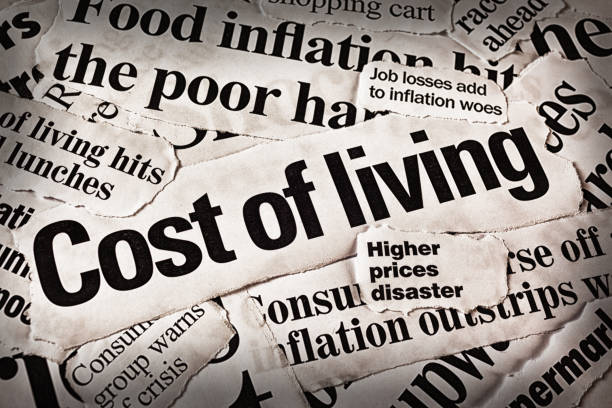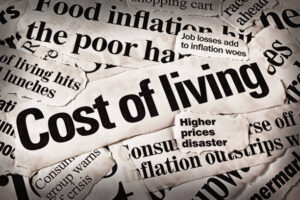Inflation starts to fall, however interest rates are still going up.
Inflation falls below 10% for the first time since August last year but the drop was smaller than expected, suggesting interest rates have not yet peaked.
-
Inflation has fallen below 10% for the first time since August last year but interest rates are expected to continue rising
-
Economists expect the Bank Rate to be increased at least twice more from its current level of 4.5%
-
The cost of fixed rate mortgages is expected to start increasing, ending the downward trend they have been on since October
Inflation has fallen below 10% for the first time since August last year but interest rates are expected to continue rising.
The rate at which the cost of goods and services is rising (as measured by the Consumer Prices Index) dipped to 8.7% in April.
But the fall was smaller than both the Bank of England and economists had predicted.
Meanwhile, core inflation actually increased, rising from 6.2% in March to 6.8% in April (its highest level since 1992).
The data suggests the interest rate hikes made by the Bank of England’s Monetary Policy Committee (MPC) so far have not been enough to tame inflation and further rises will be needed.
Economists now expect the Bank Rate to be increased at least twice more from its current level of 4.5%, with predictions suggesting it will peak at 5.25%.
Why is this happening?
Inflation has been running at double digits during the past year due to a number of external factors, including the conflict in Ukraine, which has pushed food and energy prices higher, the resumption of normal life after Covid and issues relating to the weather, which both fuelled demand for energy and impacted food harvests.
The MPC had sought to bring inflation back under control by increasing interest rates from a record low of 0.1% to 4.5%.
But so far, higher borrowing costs appear to have had little impact.
Although inflation eased from 10.1% to 8.7% in April, core inflation, which measures price rises excluding volatile sectors such as food and energy, continued to increase.
This suggests that high inflation could be becoming entrenched and is now being driven by domestic factors, such as wage increases, rather than external factors, such as the conflict in Ukraine.
With inflation still more than four times its 2% target, the MPC has little choice but to continue raising rates in the hope of bringing it down.
How does inflation is falling effect the cost of living?
While it is good news that inflation is falling, you won’t feel better off just yet.
The reason for this is that although the rate at which inflation is rising has dropped, this doesn’t mean that things have got cheaper.
In fact, it simply means that the rate at which the price of things is increasing has slowed down. In other words, things are now an average of 8.7% more expensive than they were in April last year.
At the same time, certain things are significantly more expensive than they were 12 months ago.
For example, the cost of food is 19.3% higher than it was a year ago, while gas and electricity prices are 24.3% higher than 12 months earlier.
We have noticed the cost of fuel fall back to pre-COVID prices.
What does this mean for the mortgage market?
Despite rising interest rates, the average cost of a fixed rate mortgage has been on a broadly downward trajectory since October last year.
The typical interest rate charged on a two-year fixed rate deal dropped by a further 0.9% in May, while the cost of a five-year fixed rate mortgages fell by 0.8%, according to financial information group Moneyfacts.
These decreases came despite the fact the MPC increased interest rates by 0.25% during the month.
But the latest inflation figures are expected to have brought this trend to an end.
Swap rates, on which fixed rate mortgages are based, are rising in anticipation of further interest rate hikes.
Mark Harris, chief executive of mortgage broker SPF Private Clients, said: “Swap rates rose on the back of the inflation figures and it is likely that more lenders will reprice their mortgages higher.
“We have already seen some volatility in pricing in recent days on the back of higher Swaps, which underpin the pricing of fixed-rate mortgages, with Santander and Halifax pulling rates. Other lenders are repricing upwards at short notice.”
Banks are still looking to make mortgages more accessible and have kept rates rather low, but still need to keep interest rates in-line with inflation and ensure that customers are able to make payments should interest rates increase again in the future.
What should I do if I need to remortgage?
If you need to re-mortgage you should probably act now. The cost of fixed rate deals are not expected to fall any further and are likely to increase in the near future.
The main decision will be deciding whether to go for a five or two-year fixed rate deal or a tracker mortgage.
Five-year fixed rate mortgages are currently cheapest, with rates averaging 4.97% – but if you take out one of these products, you will be locking into high interest rates for the next five years.
Two-year deals are slightly higher at an average of 5.26%, but the fact that they are more expensive than five-year ones suggests mortgage lenders are expecting rates to come down in the medium term.
Two-year tracker mortgages currently average 5.07%, but these products move up and down in line with changes to the Bank Rate, so if interest rates rise by a further 0.75%, so will your mortgage rate.
It is worth remembering that all of these rates are just averages and there are still deals available for just over 4%.
If you need to re-mortgage later this year, remember you can ‘book’ a mortgage rate for up to six months before your current deal expires.
Standard variable rate mortgage rates, the product borrowers are automatically put on if they do not re-mortgage once their current deal ends, currently stand at 7.37%, the highest level since December 2007. So, it is important to have a new deal lined up for when your current one ends.
With the mortgage market evolving rapidly and the outlook uncertain, it might be worth considering using a mortgage broker to help you find the deal that is right for you.
Is there any good news?
Despite inflation remaining high and interest rates expected to rise further, there is some good news.
The UK is now expected to avoid going into recession this year. The International Monetary Fund has revised its forecast for the UK and is now predicting the economy will grow by 0.4%, instead of its previous prediction that it would shrink by 0.3%.
The second bit of good news is that although higher mortgage rates and the cost-of-living squeeze has hit consumers’ pockets, the housing market has remained resilient.
In fact, our latest House Price Index found that both buyer demand and sales levels were recovering, and house prices have remained broadly unchanged, losing only 0.7% of their value during the past three months.
Overall, we expect property values to end 2023 just 1% lower than they started it.
Finally, the end is now in sight for high gas and electricity bills.
Energy regulator Ofgem has just announced that it is reducing the energy price cap to £2,074 from July 1, from its current level of £3,280 – although this is lowered to £2,500 by the government’s Energy Price Guarantee.
The drop means the typical annual household energy bill will be £2,074 from July, although the actual amount people pay depends on how much energy they use.



